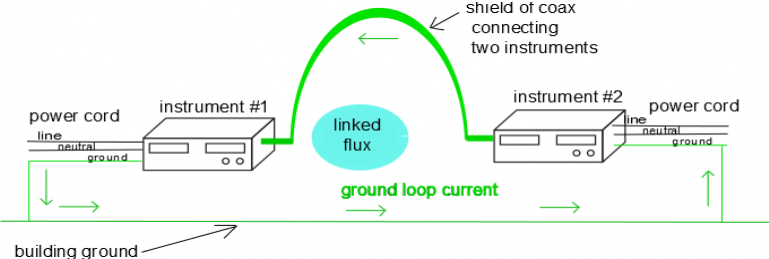US Patent 7,791,353 B2
Introduction
Simple Circuit Concepts
Transmission lines
Faraday's law
Near and far fields
Spurious coupling mechanisms
- Direct conduction
- Capacitive coupling -problem
- Capacitive coupling -fixing
- Inductive coupling-problem
- Inductive coupling -fixing by twisted
- Inductive coupling -fixing by coax
- Electromagnetic pickup
- Examples
- Safety & star grounding
- Gnd loop resistance, inductance
- Low frequency behavior
- High frequency behavior
- Troubleshooting
- Methods for removing
Ground Loop Examples
Three examples of ground loops are given below. In each case a measuring instrument such as a meter, oscilloscope, display monitor, computer, or multiplexer is connected via a cable or cables to one or more kinds of signal source such as a microphone, camera, photodiode, photomultiplier, thermocouple, magnetic probe, accelerometer, or any other device that provides a low-level voltage or current containing information to be processed. In each case an extraneous loop involving the shield (common) connection of the signal links a spurious time-dependent magnetic flux produced by some external circuit.
Example (a): Here as shown below the measuring instrument is plugged into the mains via a power cord with a ground wire and the instrument chassis is connected to ground via this wire. The sensor is connected to the measuring instrument via a coaxial cable (or equivalently by a twisted pair, not shown here). There is an inadvertent short of the coaxial cable shield to ground anywhere along the length of the cable so there is a complete circuit (loop) formed by the coaxial cable shield, the inadvertent short to ground, and the power cord ground; this unintended circuit is the ground loop. Time-dependent stray magnetic flux from some external circuit (e.g., a motor, fluorescent lights, a power supply, a computer) links this loop. In accordance with Faraday's law, the time dependent stray magnetic flux produces a voltage that drives a current that flows around the ground loop (ground loop current shown as green arrows). Voltage drops associated with the ground loop current add to the voltage produced by the sensor and interfere with the sensor signal.
Three examples of ground loops are given below. In each case a measuring instrument such as a meter, oscilloscope, display monitor, computer, or multiplexer is connected via a cable or cables to one or more kinds of signal source such as a microphone, camera, photodiode, photomultiplier, thermocouple, magnetic probe, accelerometer, or any other device that provides a low-level voltage or current containing information to be processed. In each case an extraneous loop involving the shield (common) connection of the signal links a spurious time-dependent magnetic flux produced by some external circuit.
Example (a): Here as shown below the measuring instrument is plugged into the mains via a power cord with a ground wire and the instrument chassis is connected to ground via this wire. The sensor is connected to the measuring instrument via a coaxial cable (or equivalently by a twisted pair, not shown here). There is an inadvertent short of the coaxial cable shield to ground anywhere along the length of the cable so there is a complete circuit (loop) formed by the coaxial cable shield, the inadvertent short to ground, and the power cord ground; this unintended circuit is the ground loop. Time-dependent stray magnetic flux from some external circuit (e.g., a motor, fluorescent lights, a power supply, a computer) links this loop. In accordance with Faraday's law, the time dependent stray magnetic flux produces a voltage that drives a current that flows around the ground loop (ground loop current shown as green arrows). Voltage drops associated with the ground loop current add to the voltage produced by the sensor and interfere with the sensor signal.
Find ground loops fast!
-eliminate electical interference, fix star grounding
-eliminate electical interference, fix star grounding
US Patent 7,791,353 B2

Example (b): Here two sensors connected to the same measuring instrument have individual coaxial (or twisted pair) cables as shown below. The shields (common) of the cables are connected to the measuring instrument's common which may or may not be grounded. The shields of the cables are also connected to each other elsewhere, e.g. at the sensors, at some point intermediate between the sensors, or via some other cable going between the sensors. Time-dependent linked magnetic flux produced by some other circuit drives a current around the loop comprised of the two shields and interferes with the sensor signals.

Example (c): Here as shown below two instruments are each connected to ground via their respective power cords and in addition are connected to each other via a coaxial cable. The building ground, power cord ground wires, and shield together form a loop which is linked by spurious time-dependent magnetic flux produced by some external circuit. In accordance with Faraday's law this stray flux drives a current around the ground loop and this current or its associated voltages interfere with the signal that is supposed to be communicated between the two instruments.
